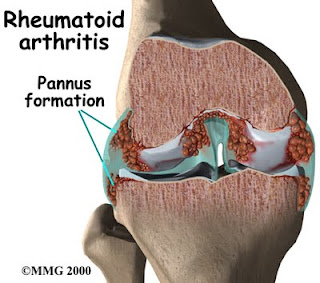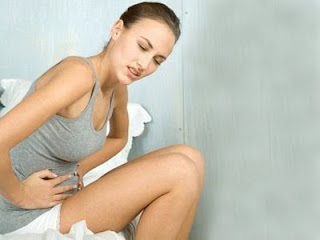Nursing Interventions Pain (Acute / Chronic) Rheumatoid Arthritis
Nursing Care Plan for Pain (Acute / Chronic) Rheumatoid Arthritis
Nursing Diagnosis for Rheumatoid Arthritis
Pain (Acute / Chronic)
related to:
1. Investigate complaints of pain, note the location and intensity (scale of 0-10). Note the factors that accelerate and signs of pain in non-verbal.
Rational: Assist in determining the need for pain management, and program effectiveness.
2. Give a hard mattress, small pillows. Elevate the bed linens as needed.
Rationale: a soft mattress, great pillows will prevent the maintenance of proper body alignment, putting stress on the joints that hurt. Elevation bed linen lowering the pressure in the inflamed joints / pain.
3. Place / monitor the use of pillows, sandbags, rolls trokhanter, splint, brace.
Rational: Resting sore joints and maintain a neutral position. The use of the brace can reduce pain and to reduce damage to the joints.
4. Push to frequently change positions. Help the patient to move in bed, prop sore joints above and below, avoid jerking movements.
Rationale: Prevent general fatigue and joint stiffness. Stabilize the joint, reduce motion / joint pain.
5. Instruct the patient to a warm bath or shower, waking and / or at bedtime. Provide a warm washcloth to compress the sore joints several times a day. Monitor the temperature of the water compresses, baths, and so on.
Rational: Heat enhance muscle relaxation and mobility, decrease pain and stiffness in the morning release. Sensitivity to heat can be removed and dermal wounds can be healed.
6. Give a gentle massage.
Rationale: Increase relaxation / relieves pain.
7. Encourage the use of stress management techniques, such as progressive relaxation, therapeutic touch, biofeed back, visualization, imagination guidance, self hypnosis, and breath control.
Rationale: Increase relaxation, provides a sense of control and may improve coping abilities.
8. Engage in recreational activities appropriate to the individual situation.
Rational: Refocus attention, stimulate, and improve self-confidence and feeling healthy.
9. Give medications before activity / exercise planned as directed.
Rationale: Increase realaksasi, reduce muscle tension / spasm, easy to participate in therapy.
Nursing Diagnosis for Rheumatoid Arthritis
Pain (Acute / Chronic)
related to:
- Tissue distension, by the accumulation of fluid / inflammatory process.
- Joint destruction.
- Complaints of pain, discomfort, fatigue.
- Focusing on yourself / narrowing the focus.
- Behavior distraction / autonomic response.
- Behavior that is carefully / protect.
- Showed pain relief / control.
- Looks relaxed, able to sleep / rest and participate in activities according to ability.
- Following pharmacological prescription program.
- Combining the skills of relaxation and entertainment activities in a pain control program.
1. Investigate complaints of pain, note the location and intensity (scale of 0-10). Note the factors that accelerate and signs of pain in non-verbal.
Rational: Assist in determining the need for pain management, and program effectiveness.
2. Give a hard mattress, small pillows. Elevate the bed linens as needed.
Rationale: a soft mattress, great pillows will prevent the maintenance of proper body alignment, putting stress on the joints that hurt. Elevation bed linen lowering the pressure in the inflamed joints / pain.
3. Place / monitor the use of pillows, sandbags, rolls trokhanter, splint, brace.
Rational: Resting sore joints and maintain a neutral position. The use of the brace can reduce pain and to reduce damage to the joints.
4. Push to frequently change positions. Help the patient to move in bed, prop sore joints above and below, avoid jerking movements.
Rationale: Prevent general fatigue and joint stiffness. Stabilize the joint, reduce motion / joint pain.
5. Instruct the patient to a warm bath or shower, waking and / or at bedtime. Provide a warm washcloth to compress the sore joints several times a day. Monitor the temperature of the water compresses, baths, and so on.
Rational: Heat enhance muscle relaxation and mobility, decrease pain and stiffness in the morning release. Sensitivity to heat can be removed and dermal wounds can be healed.
6. Give a gentle massage.
Rationale: Increase relaxation / relieves pain.
7. Encourage the use of stress management techniques, such as progressive relaxation, therapeutic touch, biofeed back, visualization, imagination guidance, self hypnosis, and breath control.
Rationale: Increase relaxation, provides a sense of control and may improve coping abilities.
8. Engage in recreational activities appropriate to the individual situation.
Rational: Refocus attention, stimulate, and improve self-confidence and feeling healthy.
9. Give medications before activity / exercise planned as directed.
Rationale: Increase realaksasi, reduce muscle tension / spasm, easy to participate in therapy.


Comments
Post a Comment